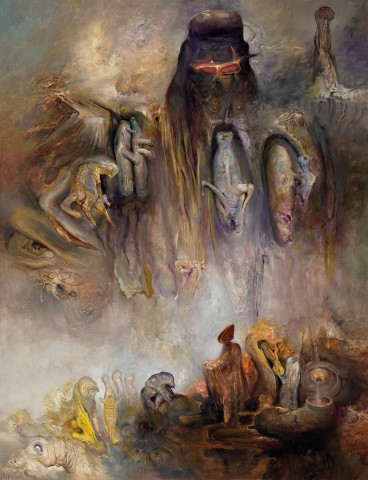IMAGES FOR A DARKENING TIME, 2003
JAMES GLEESON
oil on canvas
178.0 x 132.0 cm
signed and dated lower left: Gleeson ‘03
signed and inscribed with title on stretcher bar verso: “IMAGES FOR A DARKENING TIME” / James Gleeson
Watters Gallery, Sydney (label attached verso)
Private collection, Queensland, acquired from the above in 2004
Watters Gallery, Sydney
Private collection, Sydney
Estate of the above
James Gleeson: Disguised Signals. New Paintings and Drawings, Watters Gallery, Sydney, 27 April – 22 May 2004, cat. 6 (illus. in exhibition catalogue)
James Gleeson: Beyond the Screen of Sight, Ian Potter Centre: NGV Australia, Melbourne, 29 October 2004 – 27 February 2005; National Gallery of Australia, Canberra, 18 March – 13 June 2005, cat. 91 (label attached verso)
Klepac, L., James Gleeson. Beyond the Screen of Sight, The Beagle Press in association with the National Gallery of Victoria, Sydney, 2004, cat. 91, pp. 188 (illus.), 189, 201
‘In his old age, Jung voiced very well our need for the unutterable: ‘It is important to have a secret, a premonition of things unknown… [Man] must sense that he lives in a world which in some respects is mysterious; that things happen and can be experienced which remain inexplicable; that not everything which happens can be anticipated. Only then is life whole’…’1
Without doubt Australia’s leading Surrealist painter and poet, for more than six decades James Gleeson has divulged the depths of his own imagination onto the canvas, offering up damning – yet simultaneously captivating – depictions of a visceral universe that defies intellectual grasp. With their typically ominous skies, huge grotesque forms and dominant motifs of metamorphosis, his landscapes are the manifestation of our inner psyche – powerfully capturing the repulsive, the erotic, the abject, and the tumultuous uncertainty of our dreams and subconscious thoughts. As Lou Klepac, author of several authoritative texts on Gleeson’s work, elucidates: ‘Gleeson’s paintings are the mirror which reveals the dark and dangerous regions which are too terrifying for our ordinary consciousness, because they represent a view of existence measured in light years where man’s life is but a flicker of a small flame.’2
Monumental in scale and conception, Images for a Darkening Time, 2003 exemplifies well the second period of Gleeson’s career during which, from 1983 until his death in 2008, ‘he embarked upon the large imaginative landscapes which constitute his greatest and most original achievement.’3 In stark contrast to his earlier explorations of ‘man as the measure of all things’, Gleeson now jettisons all interest in the representation of the human figure, transfixed instead by the mutability of forms and possibility of ‘a biomorphic cosmos’ – as might have existed pre-civilisation, or might yet occur after the obliteration of humanity. As Gleeson asserts, ‘I got to the point where the extreme (of the figure) almost came to be recognisable – then I felt no need to use the form at all as an entirety. It could be represented by an arm, a hand, an eye. I broadened it to be not only landscape but cosmic experience.’4
Featured in the major retrospective James Gleeson: Beyond the Screen of Sight held at the National Gallery of Victoria in 2004, the present is a dynamic and potent work that contains all the visceral urgency and emotional gravity which distinguishes the artist’s late work. As Klepac elaborates, ‘…James Gleeson’s late paintings will no doubt be interpreted as the world reduced to an illogical and disturbing state as a punishment for something that mankind has done. The paintings do have an air of prophecy, and many will interpret them as reflecting our fear of global extinction since this has become a universal anxiety… Rather than being images of possibility influenced by time, Gleeson’s paintings are the final development of the universal and always present question about the nature of reality…
Not even Gleeson can be the final interpreter of this amazing series of late works. The artist has acted as a ‘medium’ to these images which have come to him in an avalanche after fifty years of serious work which now seems as though it may have been the preparation for a newfound language and most eloquent voice. Perhaps most remarkable of all is that these paintings have had to be developed on a large scale in order to affirm the inevitability of these images and the essential, positive presence of the world which they represent. The scale is an essential part of the vision. That they are so also affirms that they could not have been painted or conceived other than by a master.
Gleeson’s world is not an upheaval of the self-conscious, nor an expression of a tormented soul… One might suggest however, that it is a reaction to, and a redressing of the positivism of a materialist age. His late work enriches us by supplying us with a world of wonder and infinite possibilities, rare in a rather arid world…’5
1. Klepac, L., James Gleeson, Landscape Out of Nature, The Beagle Press, Sydney, 1997, p. 10
2. Klepac, L., James Gleeson: Beyond the Screen of Sight, The Beagle Press, Sydney, 2004, p. 9
3. Ibid.
4. The artist, quoted in Free, R., James Gleeson: Images from the Shadows, Craftsman House, Sydney, 1993, p. 43
5. Klepac, op. cit., 1997, pp. 9 – 10
VERONICA ANGELATOS
